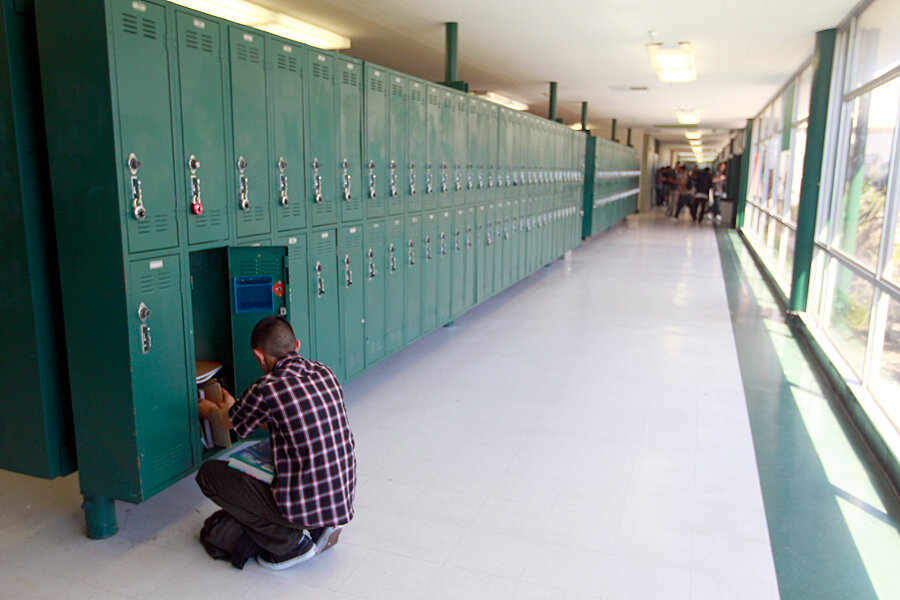When school discipline is unfair: four ways to do better
Loading...
A black boy in baggy pants is disciplined, while a white girl in a short skirt, also against the dress code, is left alone. A girl gets suspended for fighting, but the principal doesn’t realize she’s been repeatedly harassed for being gay.
A new set of reports dives deep into the complex causes of such inequities in school discipline – along racial and other lines – and offers more details on what schools can do to create a climate that is both orderly and fair.
“All schools see a wide range of adolescent misbehavior, but school responses vary dramatically. Some schools see an educational mission in teaching appropriate behavior and are successful at improving behavior without resorting to suspension and expulsion,” said Daniel Losen, director of the Center for Civil Rights Remedies at the University of California at Los Angeles, in a statement Thursday releasing the new work from the Discipline Disparities Research-to-Practice Collaborative.
Racial disparities in discipline drew national attention recently when President Obama announced “My Brother’s Keeper” to improve the lives of young men of color. African-American, Hispanic, and native American students have all been shown to have higher rates of suspension and expulsion than do white students, leading to a higher likelihood of dropping out of school. African-American students are 1.78 times more likely to be suspended out of school, according to one study.
But disparities aren’t just along racial and ethnic lines. Disabled students are suspended almost twice as often as non-disabled students. And students who reported same-sex attractions in surveys had higher odds of being expelled, even after controlling for factors such as poverty, race, and misbehavior.
These are some of the facts highlighted Thursday by the Discipline Disparities collaborative – 26 researchers, advocates, educators, and policy analysts whose work over the past three years has been funded by the Atlantic Philanthropies and Open Society Foundations.
The unevenness in discipline can’t be explained away by poverty or by higher rates of misbehavior, the researchers have concluded. Instead, school factors, such as the principal’s attitude about discipline, have a stronger effect.
The collaborative highlighted a number of steps schools can take to improve climate and safety and reduce discipline disparities. Among them:
• Strengthen student-teacher relationships. Black, Latino, and LGBT students less often see school staff as supportive. But teachers who systematically get to know their students and reflect on how they interact can make a difference.
My Teaching Partner, for instance, pairs teachers with a coach for a school year, enabling them to reflect on video recordings of their classroom interactions with students. A randomized, controlled study showed that for participating teachers, the black-white gap in their student discipline practices was eliminated.
• Establish a respectful and bias-free environment. People across racial lines tend to establish white faces with words like “smart” and black faces with criminality, researchers have shown. Educators can learn to pause and make sure they aren’t making snap judgments of students based on unconscious bias.
They can also analyze their own discipline data to look for unfair patterns. One middle school principal showed the staff they were not enforcing rules against short skirts as much as they were against baggy pants, more typically worn by boys of color.
• Take a problem-solving approach. In contrast to a zero-tolerance approach, schools should look at the context around behavior problems and tailor their responses. Schools may discover, for instance, that a student breaking rules feels unsafe or has experienced trauma.
Schools that trained staff in the Virginia Student Threat Assessment Guidelines to investigate underlying problems have been found to have a more positive climates and issue fewer suspensions. They have also reduced the black-white discipline gap.
Restorative justice, which focuses on preventing and resolving disputes, led to suspension rates dropping by 47 percent in Denver Public Schools over five years, with rates dropping the most for African-American and Hispanic/Latino students.
• Reintegrate students after conflict. After long suspensions or stays in juvenile facilities, students can have trouble catching up and can feel stigmatized. Schools can offer support services, such as a transition center where community organizations provide an advocate for the student and can collaborate with teachers and probation officers.
Ramiro Rubalcaba, principal of Azusa High School in California, spoke about his transformation from skeptic to advocate of such ideas in discipline reform, in a conference call Thursday afternoon. The former district he worked for told school leaders to stop suspending students for the broad category of “willful defiance” and trained them to implement more positive approaches. Suspension rates plummeted.
He brought those ideas to his current school recently. It had 70 suspensions last year at this time, and this year it has had three. The school holds students and staff accountable not just for academic results, but for positive behavior. “We’ve experienced success because we are using evidence-based strategies,” he said.






